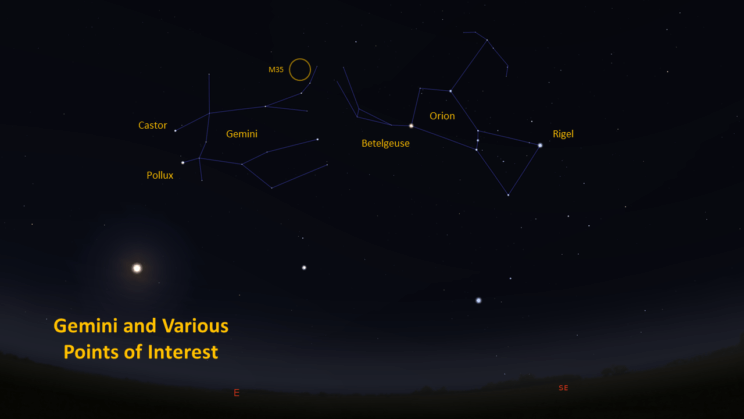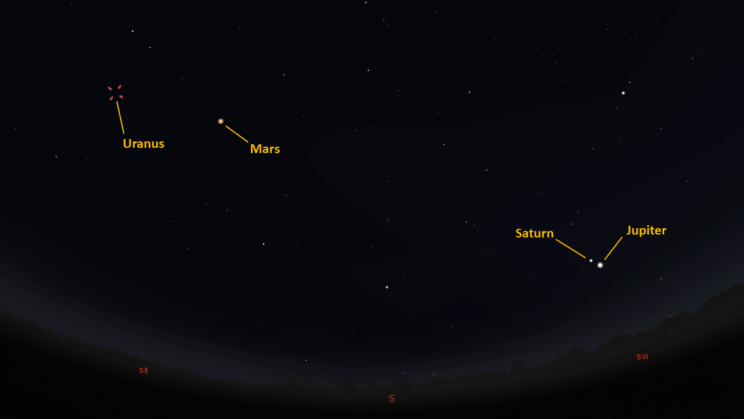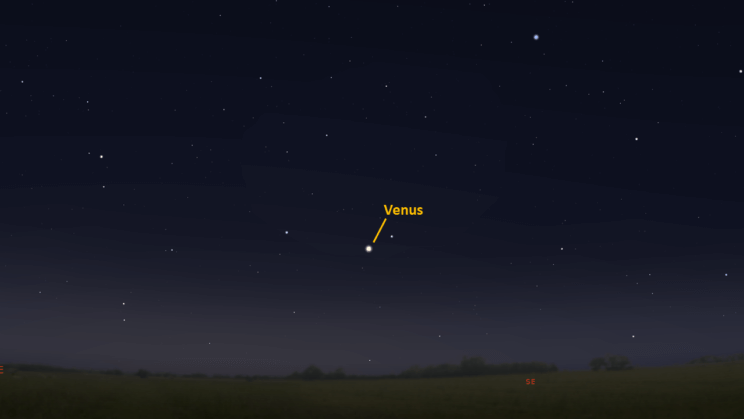This is the Saint Louis Science Center’s NIGHT SKY UPDATE for the week of Friday, December 4, 2020.
Information updated weekly or as needed.
Times given as local St. Louis time which is Central Standard Time (CST). For definitions of terminology used in the night sky update, click the highlighted text. If relying on times posted in Universal Time (UT), St. Louis is now -6 Hours from UT.
Public Telescope Viewings
Star parties at the Saint Louis Science Center have temporarily been canceled due to recommendations from the CDC regarding COVID-19. All public telescope events are canceled until further notice. As conditions change, we will reevaluate and update this article once public observing events resume.
Observing Highlight of the Week
Gemini and Various Objects
Credit: Stellarium, EG
This week we will talk about the constellation Gemini. This zodiacal constellation is an important one to know because the Sun, Moon and planets are all periodically found in Gemini. Aside from this it has several interesting targets, and it is where the radiant for the upcoming Geminid meteor shower is found.
Gemini is named after the twins Castor and Pollux from Greek mythology. It is a prominent constellation in the winter sky being found northeast of the constellation Orion. It is easily found by using the two bright stars in Orion called Rigel and Betelgeuse. If you follow a line from Rigel to Betelgeuse, this will point you up to a narrow rectangle group of stars that is Gemini. The two bright stars at the top of Gemini are Castor and Pollux.
For binocular observers, there is an open star cluster named M35 that is a nice target. It has several hundred stars and its Trumpler classification is III 3 r meaning it is detached from the background stars and has no noticeable concentration. At 5.3 magnitude, its brightest stars are easy to see in binoculars, but it can be tricky to see because of its lack of concentration.
The star Castor is a great multiple star system for telescope users. At lower magnifications you should easily see two bright stars when viewing Castor. At higher magnifications you might catch a third star. Castor, however, is not a triple star system but rather it is six stars. The three stars that are visible are each two stars.
Lastly, I wanted to cover Gemini this week leading up to next week’s peak of the Geminid meteor shower. This year is a good year for the Geminids due to the moon phase being favorable. From dark locations, the Geminids can produce up to 150 meteors per hour. We will cover the Geminids in more detail next week. In preparation for the Geminids, this week is a good chance to try and find the constellation that is home to this meteor shower’s radiant.
The Sun and Moon

The Moon as seen from the International Space Station, on July 31, 2011.
Credit: NASA
Sunrise is at 7:03 a.m. on Friday, December 4 and sunset is at 4:40 p.m. providing us with less than 10 hours of daylight. Even after sunset, the light from the Sun will dimly illuminate our sky for about 1 hour and 30 minutes. This period is called twilight, which ends around 6:14 p.m. this week. For those with a sundial, local noon occurs around 11:52 p.m. this week.
| Day | Sunrise | Sunset |
|---|---|---|
| 2020-12-04 | 7:03 a.m. | 4:40 p.m. |
| 2020-12-05 | 7:04 a.m. | 4:40 p.m. |
| 2020-12-06 | 7:05 a.m. | 4:40 p.m. |
| 2020-12-07 | 7:06 a.m. | 4:40 p.m. |
| 2020-12-08 | 7:04 a.m. | 4:40 p.m. |
| 2020-12-09 | 7:08 a.m. | 4:40 p.m. |
| 2020-12-10 | 7:09 a.m. | 4:40 p.m. |
| 2020-12-11 | 7:09 a.m. | 4:40 p.m. |
| 2020-12-12 | 7:10 a.m. | 4:40 p.m. |
Moon
Moonrise for Friday, December 4 occurs at 10:31 p.m. and moonset will occur at 11:27 a.m. on the following day. On Friday, December 4 the Moon will exhibit a waning gibbous phase with 82% of the lunar disk illuminated. Last quarter moon occurs on December 7 at 6:37 p.m.
International Space Station (ISS) Observing

Visible passes of ISS from St. Louis for the week of December 4 occur during evening hours. The best passes this week occur on the evenings of December 7 and 8. Use the table below for information about these and other visible passes this week.
Catch ISS from St. Louis starting Friday, December 4
| Date | Starts | Max. altitude | Ends | |||||||
|---|---|---|---|---|---|---|---|---|---|---|
| Time | Alt. | Az. | Time | Alt. | Az. | Time | Alt. | Az. | ||
| 04 Dec | -1.8 | 17:31:11 | 10 | NNW | 17:33:13 | 15 | NNE | 17:34:20 | 13 | NE |
| 05 Dec | -2.8 | 18:19:40 | 10 | NW | 18:22:04 | 34 | N | 18:22:04 | 34 | N |
| 06 Dec | -2.7 | 17:32:15 | 10 | NNW | 17:35:12 | 27 | NNE | 17:32:02 | 17 | ENE |
| 06 Dec | -0.9 | 19:08:57 | 10 | WNW | 19:10:02 | 18 | WNW | 19:10:02 | 18 | WNW |
| 07 Dec | -3.4 | 18:21:11 | 10 | WNW | 18:24:30 | 63 | SW | 18:25:16 | 45 | SSE |
| 08 Dec | -3.9 | 17:33:33 | 10 | NW | 17:36:55 | 72 | NE | 17:40:15 | 10 | ESE |
| 09 Dec | -1 | 18:23:21 | 10 | W | 18:25:50 | 19 | SW | 18:28:18 | 10 | S |
| 10 Dec | -1.9 | 17:35:15 | 10 | WNW | 17:38:20 | 34 | SW | 17:41:24 | 10 | SSE |
Magnitude (Mag): The Measure of brightness for a celestial object. The lower the value is, the brighter the object will be.
Altitude (Alt): The angle of a celestial object measured upwards from the observer’s horizon.
Azimuth (Az): The direction of a celestial object, measured clockwise from an observer’s location with north being 0°, east being 90°, south being 180° and west being 270°.
For information about ISS flyovers and other visible satellites, visit www.heavens-above.com
Detailed information regarding all unmanned exploration of our universe, missions past, present, and planned, can be found at Jet Propulsion Laboratories:
The Visible Planets

Looking South, at 6:00 pm, December 4, 2020
Credit: Stellarium, EG

Looking Southeast, 6:00 am, December 5, 2020
Credit: Stellarium, EG
This week, four naked eye planets are visible. Jupiter and Saturn are found in the southwest once it is dark. Mars is found high in the east after sunset. Venus can be found in the eastern sky before sunrise.
For those tracking Jupiter and Saturn as they approach their great conjunction later this year, the two gas giants currently appear about 1.7° apart in the sky. From now until December 21, Jupiter will appear closer to Saturn each night.
Venus
Venus rises at 4:46 a.m. and will be easily seen by 5:30 a.m. Venus remains a morning object until March 26, 2021 when it reaches superior conjunction. Since Venus has passed greatest western elongation, it is exhibiting a gibbous phase.
Mars
Currently Mars appears as a -1.1-magnitude object that will be visible in the east about 30 minutes after sunset. Mars sets by 2:39 a.m. We are still near enough to Mars that surface features are visible through telescopes. Earth is moving away from Mars which means Mars is getting fainter each night. The observing season for this apparition ends around March 10, 2021 and superior conjunction occurs on October 7, 2021.
Jupiter
Look for Jupiter in the south about 30 minutes after sunset. Jupiter will set at 7:52 p.m. Those with a telescope can enjoy views of Jupiter’s cloud features and the Great Red Spot when it is pointed towards Earth.
Saturn
Look for the ringed planet in the south about 30 minutes after sunset. Saturn sets at 8:03 p.m. For those with a telescope keep track of the orientation of Saturn’s rings. Since Saturn is tilted on its rotational axis, we cross the plane of Saturn’s ring every 13 to 15 years. We are headed towards another ring plane crossing on March 23, 2025. Over the next five years you will notice Saturn’s rings will gradually incline towards an edge on appearance.
Uranus
Uranus is not a planet we normally include in this section. Even at its dimmest, the giant planet does hover within naked eye visibility. That said, it is so close to the visible limit of the human eye it just is not reality for most of us to see Uranus without binoculars or a telescope. Uranus is just past opposition and as such, it is still easy to spot. You can find Uranus in the constellation Aries the Ram. The current magnitude for Uranus is 5.7. A finder chart for Uranus can be found here.
2020 Great Conjunction
This year the planets Jupiter and Saturn will reach conjunction. A conjunction is when two or more celestial bodies share the same right ascension. For Jupiter and Saturn this astronomical event occurs every 20 years. The conjunction occurs on December 21, 2020. You will find the two planets close together in the southwest just after sunset on this date.
Visit the James S. McDonnell Planetarium for more information on what’s up!
Night Sky Update: December 4-December 12, 2020






